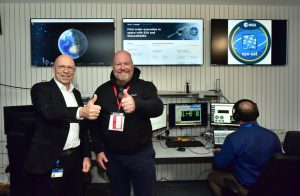
OPS-SAT is a cubesat specifically designed to trial and test innovative new software from European companies and other entities, including universities, research institutes and government agencies.
The online broker flatexDEGIRO had adapted their software to the demands and constrained bandwidth of the orbiting platform at 500km altitude.
The justification for the experiment was that it provided an opportunity to test how to improve the reliability, storage efficiency, communication and security of financial transactions.
“Having a trading platform come on board OPS-SAT was a bit unexpected. But when you think about it, it makes perfect sense,” says ESA’s David Evans, OPS-SAT Mission Manager.
“Executing stock trades and flying a satellite present many similar challenges, like the high cost of making a mistake, how to keep systems running around the clock and protection from cyberattack while remaining open to the Internet. Bringing these two worlds together is a unique and fruitful exchange.”
OPS-SAT
OPS-SAT can host a range of experiments, spanning artificial intelligence, advanced communication protocols and compression techniques, software-defined radio, optical communication, advanced autonomous planning and web services in space.
The free-to-use system was first launched in December 2019 and since then more 200 experiments have since been run, flying the relevant software in orbit.
It consists of an ‘Altera Cyclone V SoC’ with an ARM dual-core Cortex-A9 MPCore and a Cyclone V FPGA. There’s also a high-resolution camera, radio antennas, optical receiver, reaction wheels and a GPS receiver.
Specifically, there’s a Fine Attitude Determination Control System (ADCS) consisting of gyros, accelerometers, magnetometers, reaction wheels, three magnetorquers and a Star Tracker.
The system is pictured, right, during testing of its solar arrays at the Graz University of Technology, Austria.
Trading spaces
On 30 September the trade execution was monitored by a team at ESA’s ESOC mission control centre in Darmstadt, Germany, although the open-platform OPS-SAT laboratory meant that it could have been done from anywhere.
The German company flatexDEGIRO used its time on OPS-SAT to trade 100 of its own shares, which sold for about €200.00.
Pictured, top, is the successful first stock trade in space, celebrated back on Earth, by ESA’s Rolf Densing, left, and CEO of flatexDEGIRO, Frank Niehage, right.